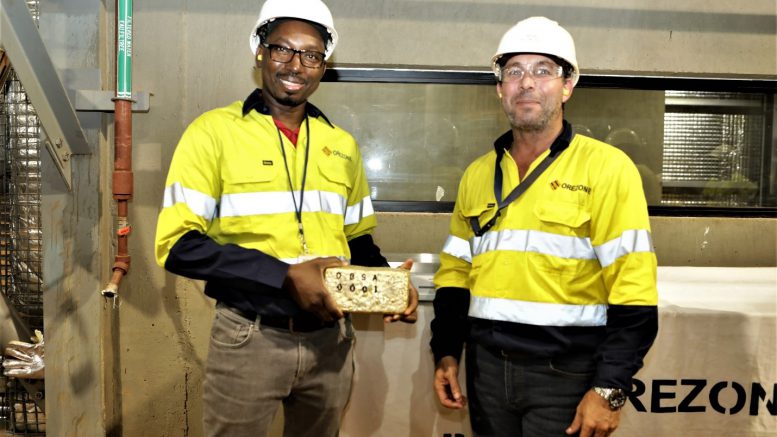Amid an ebbing of mining investment sentiment as project proponents big and small take a pause and wait out decade-high inflation and high interest rates, West Africa is an outlier, emerging as a region where mine construction timelines are met, builds get completed under budget and discovery potential beckons more investment.
The Northern Miner recently caught up with a handful of mineral explorers and miners attending the Precious Metals Summit in Beaver Creek, Colo. Even though West Africa has seen recent political instability, including coups in Guinea late last year and in Burkina Faso in early 2022, and some areas (generally away from the mining operations) have seen insurgent fighting, each executive exuded a sense of business confidence contrasting in some cases with the realities of doing business in North America and elsewhere in recent quarters.
In early September, Orezone Gold (TSX: ORE; US-OTC: ORZCF) became Burkina Faso’s newest gold producer after completing the Bomboré mine’s first gold pour under budget, on time, and with no lost time injuries, said president and CEO Patrick Downey.
“West Africa is where the mining industry can still execute construction plans as planned,” he said at the conference.
“In a short span of twenty months, we have successfully financed and constructed this greenfield project, and mined over 15.7 million tonnes of material, including 5.8 million tonnes of ore, while maintaining the health and safety of our workforce.”
While certain aspects of the US$153-million build lent themselves to faster construction — such as the plant not requiring a building enclosure which allows for ease of installation access — using contractors familiar with the region was equally important.
“Supply chain transportation was crucial for us,” Downey said, adding the company put together a strong team and contracted engineering company Lycopodium, which has a track record of success there.
Downey said the company expects to achieve commercial production in two to three months, following several weeks of consistent production at 90% of the 14,000-tonne-per-day throughput while achieving 95%-plus recoveries. “We’ve already been up to 12,000 consistently over five to seven days,” said Downey.
Meanwhile, the company has been conducting an exploration drilling program at the site, with results pointing towards a discovery.
“Because we were under budget, we went to our banks and showed them our drill results from 2018 to 2019 and what we would like to follow up on. But to keep a good schedule, we wanted to drill in 2022 because that will allow us to update the resources and reserves with a view towards an expansion and keep us on a driven value-added schedule,” said Downey.
The company recently reported the final results for the third phase program from P17S-NE along the P17 mineralized trend at its Bomboré mine.
Downey says the program was designed to better define the continuity of the repeat, folded high-grade granodiorite mineralized zones. The drill results continue to be very positive, and the down-plunge continuity of the mineralized zones at P17S has now been extended another 100 metres beyond the previous set of drill results. The mineralized zones remain open towards the surface and at depth over a strike exceeding 300 metres. With the system still open, drilling continues intercepting significant new mineralization outside the current resource boundaries.
“We see a rapid transition into a resource and reserve update in the first half of 2023, including a feasibility study update and getting into the early-stage engineering and construction for our Phase II expansion,” said Downey.
Bomboré has a significant underlying sulphide resource to support a more extensive second-phase expansion. A 77,000-metre infill and expansion drill program is ongoing.
Regional upside
Meanwhile, Sarama Resources (TSXV: SWA; ASX: SRR) is working towards growing its existing multi-million-ounce resource at its Sanutura project in Burkina Faso, with its drill program of over 50,000 metres continuing to expose near-surface, high-grade gold.
CEO and managing director Andrew Dinning told The Northern Miner that drilling at the MM prospect at Sanutura confirmed the presence and continuity of previously defined shallow, higher-grade shoots. It has also intersected new high-grade oxide mineralization outside of the current resource.
Sarama’s latest drill results at Sanutura returned grades of over 20 grams of gold per tonne from just 30 metres depth.
The most notable intersections featured 7 metres grading 8.25 grams gold per tonne from 53 metres; 11 metres at 4.5 grams from 30 metres, including 1 metre at 20.2 grams gold; and 5 metres at 9.13 grams gold from 65 metres, which ended in mineralization.
“These results are significant for Sarama because they are expected to grow the current oxide component of the already large gold resource of 2.9 million ounces,” Dinning said.
The existing oxide resource component makes up close to 1 million ounces of the total resource.
With drilling intersecting high-grade gold outside the resource and confirming the continuity in “high-value” oxide zones, Dinning said that MM remains the economic focal point of the deposit, and it is encouraging that new shallow mineralization continues to be discovered there.
Dinning said the latest results built upon the recently reported exploration success at the Obi prospect, where extensive, flat-lying mineralization with high-grade zones in oxide material was delineated, suggesting a new geological model for target generation.
“The MM and Obi prospect drill results illustrate the potential for further additions to the already significant oxide and transition component of the project’s mineral resource,” he said.
Dinning underlined the significant exploration success others have enjoyed in West Africa in recent quarters, particularly ASX-listed juniors, who he said have a better risk appetite than some North America-based counterparts.
Examples include the 4.2 million oz. exploration success at Predictive Discovery’s (ASX: PDI) Bankan gold project in Guinea, which had propelled it to a A$350-million ($311.2 million) market cap explorer in recent months.
Dinning noted that at its height, Predictive’s share price jumped more than 2,000% since discovering Bankan in 2020.
Another example is West African Resources (ASX: WAF), which in the past year has been catapulted to a A$1.3-billion producer in Burkina Faso, with solid cash flow from unhedged gold production ramping up to 400,000 oz. per year by 2025.
“By comparison, Sarama’s market value of around A$20 million represents a deeply discounted valuation for the project’s resource,” Dinning says.
“Even more so considering that the current drill program is anticipated to yield a significant resource increase.”
The Sanutura project is located just 60 km south of Endeavour Mining’s (TSX: EDV; ASX: EDV) 5-million-oz. Houndé mine, 120 km south of Fortuna Silver Mines’ (TSX: FVI; NASDAQ: FSM) high-grade 1 million oz.-plus Yaramoko mine and 140 km south of Endeavour’s 5-million-oz. Mana mine, highlighting the significant endowment of the Houndé gold belt.
From a future development point of view, over 4 million oz. of gold – the bulk of which is within 150 metres of the surface – has been defined within a 6-km radius of the Sanutura project’s 2.5 million oz. Tankoro deposit, with Endeavour’s 1.5-million-oz. Bantou project situated immediately to the west.
The Tankoro deposit sits within an extensive mineralizing system that so far has been drill-defined for a semi-continuous strike length of 16 km. Potential exists to expand the resource at shallow depths in oxide material.
Notably, 80% of Tankoro’s ounces sit within the MM and MC prospects, providing a lot of scope to discover additional large high-grade zones, as Sarama recently demonstrated at the Obi prospect.
Dinning said the company would prioritize follow-up drilling, including greenfield exploration drilling during the year’s second half.
Discovery potential
Another junior making material progress is Newcore Gold (TSXV: NCAU, US-OTC: NCAUF) which has just embarked on another 5,000 metres of diamond and reverse-circulation drilling at the 100%-owned Enchi gold project in southwest Ghana. The program is designed to follow up on discoveries made as part of a recently completed 90,000-metre drill program.
President and CEO Luke Alexander said the next phase of drilling would continue to focus on resource expansion at existing deposits, identifying higher-grade potential at depth, and also defining the broader potential for Enchi to host a long-life gold camp by drilling earlier stage targets.
Newcore has defined resources at four deposits at Enchi: Sewum, Boin, Nyam and Kwakyekrom.
Alexander underlined that the 2020 to 2022 drilling campaigns had encountered strong results at previously drilled zones outside of the resource area, including Kojina Hill and Eradi, while also intersecting high-grade gold at depth, outlining the potential to delineate underground resources.
The program also identified discoveries via first-pass drilling on early-stage targets at Sewum South, Tokosea and the Sewum Ext. Parallel Structure.
Results from the 90,000-metre drill program will be incorporated into an updated resource estimate expected later this year.
The project currently hosts a 1.4 million oz. inferred resource in 70.4 million tonnes grading 0.62 gram gold per tonne.
“Since we relaunched Newcore in mid-2020 with a renewed focus on exploration, we have not only retained strong alignment with shareholders through management and director’s 24% equity interest, but we have also built out a very strong institutional shareholder base that currently owns approximately 40% of the equity. We have completed two resource updates and a PEA, and we have now also completed the largest drill program ever on the project,” Alexander said.
“Our multi-pronged exploration approach delivered on the objectives we set at the start. We outlined near-surface resource expansion potential along strike at all four of our existing deposits, we achieved strong results from drilling at previously drilled areas, we encountered high-grade intercepts at depth which outlined the potential for delineating underground resources, and we made three new greenfield discoveries.”
The executive said that Ghana is emerging as the sixth largest gold producer globally. “Look at what the major companies are doing in the country. You’ve currently got three of the top 10 largest gold producers who have significant operations in the country” That includes Newmont (NYSE: NEM), which is in the process of investing another US$750 to US$850 million into the country, he said.
“That’s significant: One-fifth of their total production will come from Ghana. They could allocate capital to any country, any province, or any jurisdiction on the planet. And Ghana is where they are investing their capital,” Alexander said.
The next phase of drilling at Enchi is planned for later this fall.




Be the first to comment on "Beaver Creek: Miners get things done in underexplored West Africa"